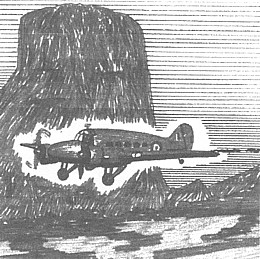Library Reference Number: 098
A Short Flight
 In July 1950 I was tasked with the job of flying an Avro 'Anson' Mk XIX from Shallufa in the Egyptian Canal Zone to Khormaksar, Aden. My squadron (No.8) had taken on an additional role of Protectorate Support Flight and required 'Ansons' and 'Austers' to perform the flights in and out of the short landing strips dotted around the Aden Protectorate.
In July 1950 I was tasked with the job of flying an Avro 'Anson' Mk XIX from Shallufa in the Egyptian Canal Zone to Khormaksar, Aden. My squadron (No.8) had taken on an additional role of Protectorate Support Flight and required 'Ansons' and 'Austers' to perform the flights in and out of the short landing strips dotted around the Aden Protectorate.
To cut a long story short, I eventually arrived at Khartoum in the Sudan after experiencing a number of problems with the aeroplane's port engine and excessive fuel consumption. The Air Force engine fitters at Khartoum spent some time on rectifying the problem, consequent to which I carried out an air test, during which everything appeared to be in full working order, thus allowing me to resume my flight to Aden. With my crew of navigator and signaller we set course for Asmara in Eritrea and for the first hour or so all was doing well until the errant engine gave a little 'cough' and splutter with a perceptible drop in revs before picking up again. When this happened a second time I requested my navigator to determine a course for the nearest possible landing strip and he came up with one at Kassala near the Sudan Eritrea border.
I altered course for this strip and it was just as well that I did so because, very shortly, the engine packed up altogether. I feathered the propeller and continued on one engine, making an asymmetric landing when we arrived at Kassala.
Whilst still airborne, my signaller had radioed Khartoum with details of our situation, so we awaited help from that source which eventually arrived in another 'Anson' and they got to work on the engine. The Political Officer based in Kassala very kindly gave us accommodation for the night so that we were ready the next morning to carry out another air test, after having been informed that the engine should now be serviceable. I carried out a very thorough and careful engine ground run and satisfied myself that the port engine in particular seemed to be performing satisfactorily.
With just my signaller aboard I taxied to the end of the landing strip, which looked extremely short from this view. I opened up to full engine revs before releasing the brakes and we quickly rolled along the strip with the engines responding perfectly. We were about halfway down the strip and almost ready to lift off when that damned engine gave up completely. 1 hadn't achieved safety speed (i.e. the speed at which it would be safe to climb away on one engine) so I had microseconds in which to make one of two choices. I could either attempt to reduce speed to stop the aircraft but which would mean an inevitable eye-watering pile up on the rocks at the end of the strip, or attempt to take off on the one engine despite the low airspeed. I chose the latter, feathered the useless propeller, wound on full rudder trim and, with full power on the starboard engine, staggered into the air.
Even with full trim and my right foot pressed hard against the rudder pedal I couldn't prevent the 'Anson' from turning left and I found that if I attempted to climb too quickly with the inevitable reduction in airspeed, the swing to left became dangerously uncontrollable. I managed to achieve a compromise with a speed just high enough to permit a slow climb and a steady turn to port. This presented yet another problem. A very high rocky outcrop was located close to the airstrip and we were now heading towards it. There was no way in which to out-climb it so I could only maintain my turn and say a little prayer, which seemed to work because we slowly flew past with quite a few metres to spare.
At five hundred feet (150 metres) I was able to level out and reduce the good engine power which also reduced the pressure being exerted by my right foot and which was beginning to feel a numbness in it. From here on it was simply a case of completing the circuit at this height and executing a single engine landing - for the second time on this landing strip! After coming to a stop, my signaller poked his head out of his radio position and enquired why we had landed so soon. Ignorance is bliss!
From take off to landing had taken about three minutes but times recorded in our Flying Log Books are to the nearest five minutes so this flight of five minutes is the shortest in my Log Book.

